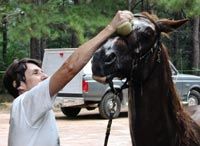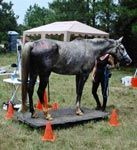The electrolyte debate heats up
Often clients will consult their veterinarians regarding conditioning, nutrition, supplementation and managing horses exercising in extreme heat.
At an equine endurance competition at Big South Fork National Forest in Tennessee this summer, the combined heat and humidity pushed the heat index to a dangerous 150 degrees. Intense heat and humidity have been the norm for much of the country this year, but equine athletic events continue to be held. During these dog days of summer, equine veterinarians must be aware of and prepared to treat the potential problems facing equine athletes performing under these harsh conditions (Photo 1).

Photo 1: A rider cools her horse during a hot, humid ride in the Southeast. Horses doing moderate to more strenuous exercise in these conditions can lose 30 pounds or more of body weight.
Often clients will consult their veterinarians regarding conditioning, nutrition, supplementation and managing horses exercising in extreme heat. These recommendations have traditionally included electrolyte supplementation. Joe Pagan, PhD, of Kentucky Equine Research calls electrolytes "essential nutrients for the performance horse," and adds that along with being essential for maximal performance, electrolyte supplementation "helps horses rebound from hard work sooner, return to feed quicker and begin the necessary rebuilding phase that occurs after exertion."
The essential elements of the electrolyte debate used to be which electrolyte mix to recommend, how much to use and when to administer it. Recent developments from the world of endurance racing, however, have added another perhaps more important question to this electrolyte discussion and might well affect how equine veterinarians advise their clients in the future.
Are electrolytes even necessary during a race?
The exceptional success of the French and Belgium endurance teams in recent international events has brought electrolyte use into question, since both of these teams administer minimal to no electrolytes during a competition. "Electrolyting is only the tip of the iceberg," says Leonard Liesens of the Belgium team. Riders from these countries are stressing harder pre-ride conditioning and more complete feeding before competition as means of avoiding electrolyte supplementation during races.
Research shows that during the average 160-km (100-mile) ride in moderately hot weather, a horse will lose about 30 to 40 liters of fluid, which includes 300 to 400 g of sodium chloride, 45 to 50 g of potassium and a small amount of magnesium. European veterinarians question whether this volume of loss can or should be replaced with the use of oral supplementation. They reason that highly concentrated electrolyte salt pastes given by mouth contribute to both oral and gastric ulceration and that this irritation can slow down the digestive process, which is a greater detriment to an exercising horse than any potential electrolyte imbalance.
"Additionally, one of the more serious repercussions with overuse of electrolytes is that athletes will third-space fluids," says Heidi Smith, DVM, an equine practitioner working at an international level at endurance events. "In other words, they begin to pull fluid back into the gut to bring the concentration of electrolytes there back to normal when they cannot transport the electrolytes across the gut wall fast enough or when the concentration is already high in the bloodstream and cells because of dehydration."
The end result may be that supplementation with concentrated electrolyte paste actually worsens dehydration in exercising horses and contributes to metabolic problems rather than helping to avoid them.
The other side of the debate
The European approach is in conflict with opinions in the United States. Here, many veterinarians reason that electrolyte supplementation will leave a horse less depleted at the end of a ride or event. They, therefore, recommend up to 10 doses of electrolytes per race, which provides 120 to 280 g of electrolytes. This volume is suggested to be the equivalent of the amount of electrolytes lost in 33 liters of sweat (Photo 2).

Photo 2: Mobile scales such as these allow competitors to weigh their horses before, during and after competition to track the volume of sweat lost and the relative success of their replacement program.
A key element, though, is that both electrolytes and fluids must be replaced for this system to work (Photo 3). The horse's digestive tract motility must remain active, and sufficient fluids must be present to allow for absorption of the administered electrolyte load. If a horse becomes dehydrated or if its digestive tract motility decreases, it is in a much more serious metabolic situation if it has been heavily supplemented with electrolytes. Yet without enough electrolytes, the horse's digestive tract function will decrease.

Photo 3: Horses at the 30-mile veterinary check of a 50-mile endurance ride replenish electrolytes and water with a diet of primarily hay and beet pulp. It is crucial that horses replace both water and electrolytes during exercise in hot conditions since either one without the other can still result in serious metabolic conditions.
Research from the Ontario Veterinary College at the University of Guelph has shown that endurance horses and event horses with less pronounced fluid and electrolyte alterations during a competition were more successful than those with greater losses. This conclusion makes intuitive sense, and European veterinarians and riders would surely agree with these findings. But the debate still rages on as to the best method of reducing fluid and electrolyte losses. And the best answer may turn out to be the simplest.
Common ground: Adequate preparation before competition
Veterinarians and physiologists on both sides of the Atlantic agree that performance horses must start their competition with adequate stores of both water and electrolytes. Pagan advises that competition horses should be eating a diet high in forage (pasture or good-quality hay) before intense exercise. Researchers from the Institute for Animal Nutrition in Hannover, Germany, proved that horses fed adequate forage maintained water and potassium balance better during exercise than horses fed a high-concentrate diet.1 "When a horse is fed liberal quantities of forage, it can store extra water and electrolytes in its large intestine," Pagan says.
Forage is a major source of potassium, containing roughly 10 to 20 g of potassium per kilogram of hay. Grass and hay also hold a large amount of water in the horse's cecum and colon. "This 'hind-gut soup,'" Smith says, "is a huge electrolyte and water reserve for the horse to draw from during the early stages of long competitions." She also adds that there are more electrolytes in one day's worth of hay consumption than the estimated losses from a 100-mile ride.
Pagan cautions, though, that forage is very low in sodium and marginal in chloride, so "supplemental (sodium chloride) salt is still required by the performance horse." The best way to achieve this supplementation is through the use of extra electrolytes administered the night before and the morning of the event, while being careful not to oversupplement. Pagan and others recommend 60 g of a balanced electrolyte supplement at each of these times.
Following this electrolyte preloading program reduces the need for large volumes of electrolytes during the competition. Supplementation should concentrate on providing additional calcium and magnesium. Pagan says, "If calcium and magnesium are not replaced by either mobilization of skeletal stores (resulting in weakened horses and poor performance) or supplementation, metabolic disturbances, leading to such complications as synchronous diaphragmatic flutter (thumps), colic or exertional rhabdomyolysis (tying-up), may occur."
Additionally, researchers at the Animal Health Trust in Newmarket, England, evaluated the electrolyte status of 144 horses suffering repeated episodes of tying-up.2 One hundred of the 144 had electrolyte values that fell outside of the normal range, and of this 100, 72 horses suffered no further episodes after receiving proper and balanced electrolyte supplementation. The use of high forage levels in the horses' diet is thought to be a principal factor in decreasing the amount of tying-up seen in performance horses, and proper pre-competition water and electrolyte loading can also help ensure that equine athletes will not only perform at their best but will be less susceptible to performance-related metabolic problems as well.
Relation to travel and stress
The concept of having a properly fed horse with optimal water and electrolyte storage before competition seems to be slowly catching on for many disciplines. Horses prepared in this manner may need minimal electrolyte supplementation during an event. The need to have a properly fed and prepared horse before competition now puts some focus on all the factors that go into getting a horse from its home environment to a show, race or event in the best condition possible. Horses that must routinely trailer for long distances or are stabled in stressful conditions before showing will more quickly use up stored water and electrolytes, will be less likely to eat and drink normally to replenish those stores, and may show up for competition in already less-than-ideal condition.
Addressing all factors that may help competition horses travel better and adjust to show stress is important. Using antacid formulations, probiotics and other pharmacological agents that can keep a horse eating and digesting well is also beneficial. While some electrolyte supplementation is likely to always be a part of equine athletic activities, especially for less-than-fit horses doing moderate exercise in hot weather, recommendations and attitudes are beginning to shift to "less is more."
Dr. Marcella is an equine practitioner in Canton, Ga.
REFERENCES
1. Meyer H, Perez H, Gomda Y, et al. Postprandial renal and faecal water and electrolyte excretion in horses in relation to kind of feedstuffs, amount of sodium ingested and exercise, in Proceedings. Equine Nutr Physiol Symp, 1987;67.
2. Harris PA, Snow DH. Role of electrolyte imbalances in the pathophysiology of the equine rhabdomyolysis syndrome. Equine Exercise Physiol 1991;3:435.